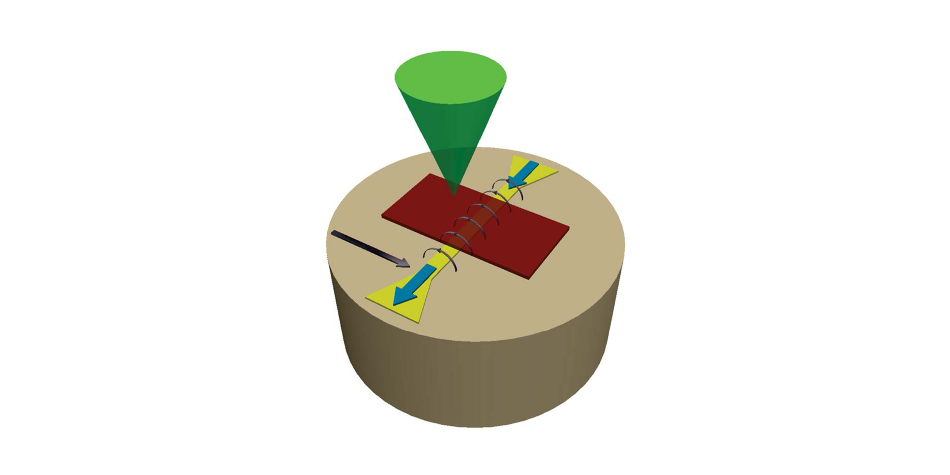Apr 27 2020
Many researchers believe that data transmission that operates through magnetic waves rather than electric currents is the foundation of upcoming technologies that will render transmission faster, and make individual components not only smaller but also more energy-efficient.
 This is how the experiment worked: The researchers used a microwave resonator (brown) that generated fields with frequencies in the microwave range, which excited the magnons in a yttrium iron garnet film (red) and formed a Bose-Einstein condensate. An inhomogeneous static magnetic field created forces acting on the condensate. Using probing laser light (green) focused on the surface of the sample, the researchers recorded the local density of the magnons and were able to observe their interaction in the condensate (Brillouin light scattering spectroscopy). Image Credit: © I. V. Borisenko et al./Nature Communications.
This is how the experiment worked: The researchers used a microwave resonator (brown) that generated fields with frequencies in the microwave range, which excited the magnons in a yttrium iron garnet film (red) and formed a Bose-Einstein condensate. An inhomogeneous static magnetic field created forces acting on the condensate. Using probing laser light (green) focused on the surface of the sample, the researchers recorded the local density of the magnons and were able to observe their interaction in the condensate (Brillouin light scattering spectroscopy). Image Credit: © I. V. Borisenko et al./Nature Communications.
Magnons are magnetic particles that act as moving data carriers. Nearly 15 years ago, scientists at the University of Münster had successfully achieved an innovative quantum state of magnons at room temperature, for the first time. These magnons were essentially a Bose-Einstein condensate of magnetic particles, also called a “superatome,” that is an intense state of matter that often takes place only at extremely low temperatures.
Since that time, it has become evident that this Bose-Einstein condensate continues to be spatially stable, albeit the concept postulated that condensate of magnons, which are striking particles, should break down.
Now, for the first time, the scientists have demonstrated, in a new study, that the magnons inside the condensates act in a repulsive way, resulting in the stabilization of the condensates.
In this way, we are resolving a long-standing contradiction between the theory and the experiment.
Sergej O. Demokritov, Study Lead and Professor, University of Münster
The results of the study may prove to be useful for developing upcoming information technologies. The study was reported in the Nature Communications journal.
Background and Method
The Bose-Einstein condensate is believed to be unique because, within this system, the particles do not differ from one another and mainly remain in the same quantum mechanical state. Hence, a single wave function can describe the quantum state, thus resulting in properties like superfluidity, for instance. Superfluidity is defined by its zero dissipation during the movement of the condensate at very low temperatures.
To date, the Bose-Einstein condensate of magnons happens to be a rare and so-called macroscopic quantum phenomenon that can potentially be visualized at room temperature.
In the past, the processes that take place in the condensate had been solely analyzed in homogeneous magnetic fields—that is, in magnetic fields that are uniformly powerful at each point, and wherein the field lines point equally in a single direction.
Just like before, the scientists used a microwave resonator, which produced magnetic fields with frequencies in the microwave range, to activate the magnons that formed a Bose-Einstein condensate.
But in the current experiment, the researchers introduced an extra, so-called potential well that matches with the inhomogeneous static magnetic field. This static magnetic field, in turn, produces forces that act on the Bose-Einstein condensate. This phenomenon allowed the researchers to directly visualize the magnons’ interaction in the condensate.
The scientists applied Brillouin light scattering spectroscopic technique for this purpose. In this technique, the local density of the magnons is recorded with a probing laser light directed on the sample surface. In this manner, the scientists successfully captured the spatial redistribution of the condensate density at varying experimental conditions.
The data, thus obtained, enabled the researchers to reach a strong conclusion that the magnons present in the condensate communicate in a repulsive way and thus maintain the stability of the condensate.
The scientists also noted two typical times of dissipation, that is, dissipation of momentum and dissipation of energy from the condensate to other states. The time taken for the dissipation of momentum demonstrated to be quite long. Incidentally, momentum dissipation refers to the momentum that elucidates the mechanical state of the movement of a physical object.
This may be the first experimental evidence for possible magnetic superfluidity at room temperature.
Sergej O. Demokritov, Study Lead and Professor, University of Münster
So far, the short lifetime of the condensate has made it complicated to utilize the condensates from magnetic particles.
Our realization of moving condensate and investigation of magnon transport as well as discovery of two different times show that the life-time has nothing to do with the momentum dissipation of the moving condensate.
Dr Igor Borisenko, Study First Author, University of Münster
The study results could thus provide new insights for applying the magnons in upcoming information technologies.
Participating Institutions and Funding
Apart from scientists from the Institute of Applied Physics and the Center for Nanotechnology at Münster University, researchers from the Russian Academy of Sciences, Texas A&M University, and the University of Cologne also participated in the research.
The QM2 Research Center of the University of Cologne and the German Research Foundation and provided financial support for the study.